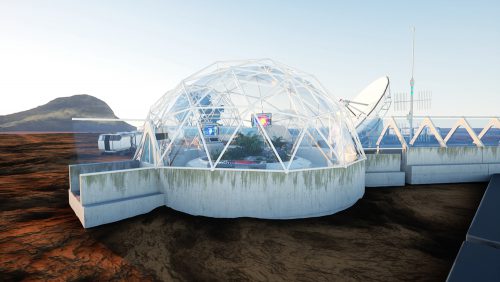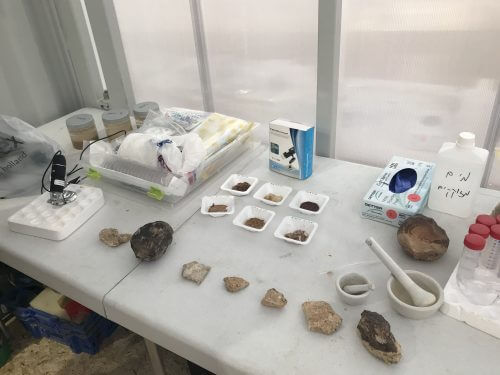After the Chinese grew cotton on the moon and the Scots launched whiskey into space, researchers in Georgia are working on the next step in the space race: winemaking on Mars
Racheli Vox, Angle - Science and Environment News Agency

Last month, Chinese scientists managed to germinate a cotton plant on the far side of the moon. Although the plant was not designed to survive the long and frozen night on the moon, the Chinese achievement joins a series of efforts aimed at understanding how plants can be grown outside the earth's soil, in order to feed the humans who will inhabit space, sometime in the future. In a new Georgian study, an attempt will be made to expand the canvas beyond the agricultural crops that are essential for survival, and the possibility of producing wine on Mars, which will delight the hearts of mankind on the Red Planet, is being examined.
Ever since man's foot landed on the moon, the human race has had its eyes set on the next destination: Mars. There are several notable differences between our home planet and its red sister: Mars is smaller than Earth (its diameter is slightly more than half the diameter of Earth), its year lasts almost two Earth years, and its atmosphere is very thin and consists mainly of carbon dioxide. However, the two neighboring planets are similar in other important features, such as day length, structure and rocky composition, making Mars, at least in theory, a possible future settlement for humans.
According to current estimates, the day when the first man will land on Mars (and enjoy a chilled glass of wine after the long flight) is not far away. SpaceX, the space company of serial entrepreneur Elon Musk, plans to send manned missions to Mars as early as 2024, and NASA aims to reach the Red Planet in the 30s. "Humanity will reach Mars in not too long," says Hadas Nabnetzel, spokeswoman for the Israeli space simulation center D-MARS, which simulates the conditions of life on Mars in the Ramon Crater. "The first person to set foot on Mars has probably already been born, maybe he even lives in Israel. We need to prepare for this day."
Agriculture at minus 60 degrees
In order for humans to be able to survive on Mars for a long time and even colonize it, they will have to produce their own food, and not rely solely on supplies from Earth. Agriculture, the method of food production that man perfected over thousands of years on the fertile soil of our home planet, is expected to be much more difficult to implement on the barren soil of Mars. "There are many challenges in the field," says Navnetzel. "There is no oxygen on Mars, we do not know what the situation is there in terms of water, we are not sure if the soil is even suitable for the growth of plants, and the gravity there is one third that of the Earth." Beyond that, the climate on Mars is far from ideal for vegetation that is adapted to the favorable conditions of Earth, and includes intense cold (the average temperature on the planet is minus 60 degrees Celsius), enormous sandstorms (like the one that threatens the continued operation of the Opportunity probe in recent months), and dangerous radiation which penetrates through the thin atmosphere and the weak magnetic field, like UV, X-ray and gamma radiation.
The agricultural efforts will be especially difficult if the desired crop is grapes for wine: as wine lovers know, the quality and quality of the drink are greatly affected by various variables, such as the characteristics of the soil, the weather, the way the vineyard is treated, and more. This is also why climate change could have a widespread impact on the wine industry here on Earth.
Grapes, strawberries and rocket
The Georgian researchers chose to focus specifically on wine in light of their country's long tradition in the field: in 2017 pottery vessels were found in Georgia that were used to make wine as early as 8,000 years ago, and some believe that the ancient wine industry began there. Wine is produced in Georgia even today, mainly from local varieties, and is a significant component of the Georgian national identity. That is why the new research project is called "IX Millennium", to mark the ninth millennium in which wine is produced in Georgia.
As part of the project, which will begin in the near future, soil samples will be exposed that will simulate the soil that is typical of Mars to the conditions that prevail on the surface of the planet. The agricultural method that the researchers will use is vertical gardening, which means that the different plants will be grown in surfaces placed one above the other, under artificial lighting and with only minimal human intervention. Along with the grapes, the researchers will also try to grow strawberries and rocket.
It will take a few more years before the research has results from which real conclusions can be drawn, but the researchers' hypothesis is that the white wine grapes, which are more resistant to viruses, are the ones that will survive best on Mars. According to them, the grape skin may reflect the radiation that harms the grapes and not allow it to penetrate into the fruit, as well as protect it from damage such as dust storms.
One of the varieties that the researchers have the most hopes for is the Rkatsiteli: green grapes with reddish spots from which a popular Georgian white wine is produced, which are known for their high resistance to cold winters and hot summers.
It is important to note that the new study will not examine how the wine itself is made, after the grapes have ripened. The main step in this process is fermentation, which occurs when wine yeast is added to the grape juice (the must), which turns the sugar in the drink into alcohol. If the researchers are successful in their mission, it will be necessary to find out how conditions such as reduced gravity will affect the process before the wine can be sipped.
space chaser
The Georgian study is not the first attempt to bring alcohol into space. The Chinese previously sent wine grapes into space, the Budweiser company performed several experiments on barley seeds on the International Space Station with the aim of becoming the first beer in space, and the Ardbeg company sent its own Scotch whiskey to outer space - and discovered that the journey in space changed its taste.
These attempts join a series of efforts designed to investigate the subject of agriculture in space. Besides the cotton plant that was germinated on the moon, red lettuce was successfully grown on the International Space Station. There are also a number of projects in the field that simulate the conditions in space here on Earth, such as a German project where scientists were able to grow a cucumber without a substrate, in a greenhouse that is able to operate at very low temperatures with its roots in the air and they receive every few minutes directly on the roots a rich spray of a mixture of minerals and fertilizers essential for their development.

Mars in the Negev
Even here in Israel they are preparing to land on Mars. At the D-MARS center, which operates in the Mitzpe Ramon area, missions are conducted designed to simulate future behavior on Mars. In these missions, which last about 11-4 days, six "ramonauts" live and work under conditions similar to those that will characterize the future missions on the neighboring planet: they live in the buildings that the astronauts are expected to live in on Mars, they are fed with suitable food, they go out into the isolated and arid area in space suits, You communicate with the control room with a delay of about ten minutes (which will be caused by the time it will take for the communication transmitter to pass between the two planets), and more.
One of the projects conducted as part of D-MARS is growing hydroponic lettuce, which was carried out as part of a program in which high school students from all over the country participated. In the hydroponic method, the plant is grown on a substrate that does not include soil, with the nutrients that the plant normally absorbs from the soil being artificially added to the irrigation water. This method could be very useful for future astronauts, especially if the soil on the surface of Mars turns out to be unsuitable for agriculture. "In an experiment conducted at D-MARS, lettuce was grown in this way with great success, which gives us hope of being able to grow hydroponic lettuce on Mars as well," Nabzel concludes.
